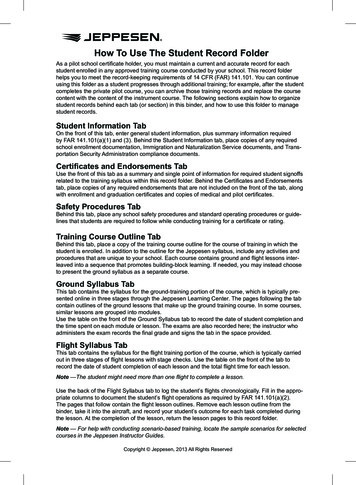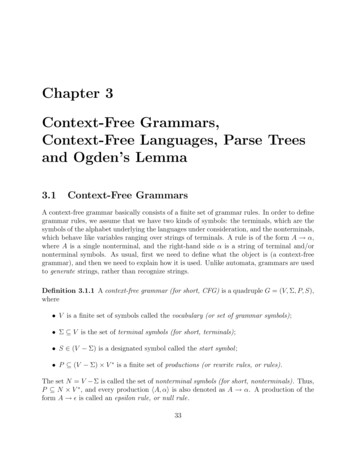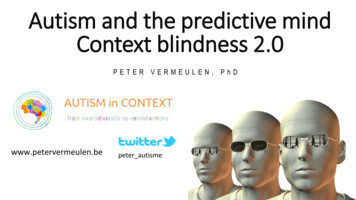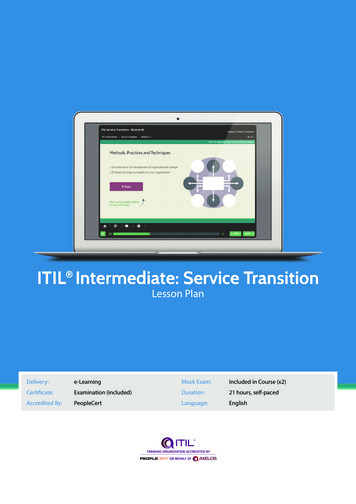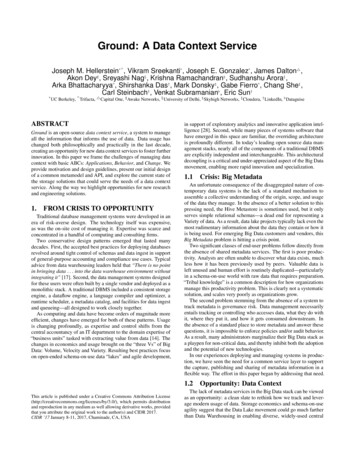
Transcription
Ground: A Data Context Service Joseph M. Hellerstein* , Vikram Sreekanti* , Joseph E. Gonzalez* , James Dalton4 ,Akon Dey] , Sreyashi Nag§ , Krishna Ramachandran\ , Sudhanshu Arora‡ ,Arka Bhattacharyya* , Shirshanka Das† , Mark Donsky‡ , Gabe Fierro* , Chang She‡ ,Carl Steinbach† , Venkat Subramanian[ , Eric Sun† * UCBerkeley, Trifacta, 4 Capital One, ] Awake Networks, § University of Delhi, \ Skyhigh Networks, ‡ Cloudera, † LinkedIn, [ DataguiseABSTRACTGround is an open-source data context service, a system to manageall the information that informs the use of data. Data usage haschanged both philosophically and practically in the last decade,creating an opportunity for new data context services to foster furtherinnovation. In this paper we frame the challenges of managing datacontext with basic ABCs: Applications, Behavior, and Change. Weprovide motivation and design guidelines, present our initial designof a common metamodel and API, and explore the current state ofthe storage solutions that could serve the needs of a data contextservice. Along the way we highlight opportunities for new researchand engineering solutions.1.FROM CRISIS TO OPPORTUNITYTraditional database management systems were developed in anera of risk-averse design. The technology itself was expensive,as was the on-site cost of managing it. Expertise was scarce andconcentrated in a handful of computing and consulting firms.Two conservative design patterns emerged that lasted manydecades. First, the accepted best practices for deploying databasesrevolved around tight control of schemas and data ingest in supportof general-purpose accounting and compliance use cases. Typicaladvice from data warehousing leaders held that “There is no pointin bringing data . . . into the data warehouse environment withoutintegrating it” [17]. Second, the data management systems designedfor these users were often built by a single vendor and deployed as amonolithic stack. A traditional DBMS included a consistent storageengine, a dataflow engine, a language compiler and optimizer, aruntime scheduler, a metadata catalog, and facilities for data ingestand queueing—all designed to work closely together.As computing and data have become orders of magnitude moreefficient, changes have emerged for both of these patterns. Usageis changing profoundly, as expertise and control shifts from thecentral accountancy of an IT department to the domain expertise of“business units” tasked with extracting value from data [14]. Thechanges in economics and usage brought on the “three Vs” of BigData: Volume, Velocity and Variety. Resulting best practices focuson open-ended schema-on-use data “lakes” and agile development,in support of exploratory analytics and innovative application intelligence [28]. Second, while many pieces of systems software thathave emerged in this space are familiar, the overriding architectureis profoundly different. In today’s leading open source data management stacks, nearly all of the components of a traditional DBMSare explicitly independent and interchangeable. This architecturaldecoupling is a critical and under-appreciated aspect of the Big Datamovement, enabling more rapid innovation and specialization.1.1An unfortunate consequence of the disaggregated nature of contemporary data systems is the lack of a standard mechanism toassemble a collective understanding of the origin, scope, and usageof the data they manage. In the absence of a better solution to thispressing need, the Hive Metastore is sometimes used, but it onlyserves simple relational schemas—a dead end for representing aVariety of data. As a result, data lake projects typically lack even themost rudimentary information about the data they contain or how itis being used. For emerging Big Data customers and vendors, thisBig Metadata problem is hitting a crisis point.Two significant classes of end-user problems follow directly fromthe absence of shared metadata services. The first is poor productivity. Analysts are often unable to discover what data exists, muchless how it has been previously used by peers. Valuable data isleft unused and human effort is routinely duplicated—particularlyin a schema-on-use world with raw data that requires preparation.“Tribal knowledge” is a common description for how organizationsmanage this productivity problem. This is clearly not a systematicsolution, and scales very poorly as organizations grow.The second problem stemming from the absence of a system totrack metadata is governance risk. Data management necessarilyentails tracking or controlling who accesses data, what they do withit, where they put it, and how it gets consumed downstream. Inthe absence of a standard place to store metadata and answer thesequestions, it is impossible to enforce policies and/or audit behavior.As a result, many administrators marginalize their Big Data stack asa playpen for non-critical data, and thereby inhibit both the adoptionand the potential of new technologies.In our experiences deploying and managing systems in production, we have seen the need for a common service layer to supportthe capture, publishing and sharing of metadata information in aflexible way. The effort in this paper began by addressing that need.1.2This article is published under a Creative Commons Attribution /), which permits distributionand reproduction in any medium as well allowing derivative works, providedthat you attribute the original work to the author(s) and CIDR 2017.CIDR ’17 January 8-11, 2017, Chaminade, CA, USACrisis: Big MetadataOpportunity: Data ContextThe lack of metadata services in the Big Data stack can be viewedas an opportunity: a clean slate to rethink how we track and leverage modern usage of data. Storage economics and schema-on-useagility suggest that the Data Lake movement could go much fartherthan Data Warehousing in enabling diverse, widely-used central
repositories of data that can adapt to new data formats and rapidlychanging organizations. In that spirit, we advocate rethinking traditional metadata in a far more comprehensive sense. More generally,what we should strive to capture is the full context of data.To emphasize the conceptual shifts of this data context, and as acomplement to the “three Vs” of Big Data, we introduce three keysources of information—the ABCs of Data Context. Each representsa major change from the simple metadata of traditional enterprisedata management.Applications: Application context is the core information that describes how raw bits get interpreted for use. In modern agile scenarios, application context is often relativistic (many schemas for thesame data) and complex (with custom code for data interpretation).Application context ranges from basic data descriptions (encodings,schemas, ontologies, tags), to statistical models and parameters, touser annotations. All of the artifacts involved—wrangling scripts,view definitions, model parameters, training sets, etc.—are criticalaspects of application context.Behavior: This is information about how data was created and usedover time. In decoupled systems, behavioral context spans multipleservices, applications and formats and often originates from highvolume sources (e.g., machine-generated usage logs). Not onlymust we track upstream lineage— the data sets and code that led tothe creation of a data object—we must also track the downstreamlineage, including data products derived from this data object. Asidefrom data lineage, behavioral context includes logs of usage: the“digital exhaust” left behind by computations on the data. As a result,behavioral context metadata can often be larger than the data itself.Change: This is information about the version history of data, codeand associated information, including changes over time to bothstructure and content. Traditional metadata focused on the present,but historical context is increasingly useful in agile organizations.This context can be a linear sequence of versions, or it can encompass branching and concurrent evolution, along with interactionsbetween co-evolving versions. By tracking the version history of allobjects spanning code, data, and entire analytics pipelines, we cansimplify debugging and enable auditing and counterfactual analysis.Data context services represent an opportunity for database technology innovation, and an urgent requirement for the field. We arebuilding an open-source data context service we call Ground, toserve as a central model, API and repository for capturing the broadcontext in which data gets used. Our goal is to address practicalproblems for the Big Data community in the short term and to openup opportunities for long-term research and innovation.In the remainder of the paper we illustrate the opportunities inthis space, design requirements for solutions, and our initial effortsto tackle these challenges in open source.2.DIVERSE USE CASESTo illustrate the potential of the Ground data context service, wedescribe two concrete scenarios in which Ground can aid in datadiscovery, facilitate better collaboration, protect confidentiality, helpdiagnose problems, and ultimately enable new value to be capturedfrom existing data. After presenting these scenarios, we explore thedesign requirements for a data context service.2.1Scenario: Context-Enabled AnalyticsThis scenario represents the kind of usage we see in relativelytechnical organizations making aggressive use of data for machinelearning driven applications like customer targeting. In these organizations, data analysts make extensive use of flexible tools for datapreparation and visualization and often have some SQL skills, whiledata scientists actively prototype and develop custom software formachine learning applications.Janet is an analyst in the Customer Satisfaction department at alarge bank. She suspects that the social network behavior of customers can predict if they are likely to close their accounts (customerchurn). Janet has access to a rich context-service-enabled data lakeand a wide range of tools that she can use to assess her hypothesis.Janet begins by downloading a free sample of a social mediafeed. She uses an advanced data catalog application (we’ll call it“Catly”) which connects to Ground, recognizes the content of hersample, and notifies her that the bank’s data lake has a completefeed from the previous month. She then begins using Catly tosearch the lake for data on customer retention: what is available,and who has access to it? As Janet explores candidate schemas anddata samples, Catly retrieves usage data from Ground and notifiesher that Sue, from the data-science team, had previously used adatabase table called cust roster as input to a Python librarycalled cust churn. Examining a sample from cust roster andknowing of Sue’s domain expertise, Janet decides to work with thattable in her own churn analysis.Having collected the necessary data, Janet turns to a data preparation application (“Preply”) to clean and transform the data. Thesocial media data is a JSON document; Preply searches Groundfor relevant wrangling scripts and suggests unnesting attributes andpivoting them into tables. Based on security information in Ground,Preply warns Janet that certain customer attributes in her table areprotected and may not be used for customer retention analysis. Finally, to join the social media names against the customer names,Preply uses previous wrangling scripts registered with Ground byother analysts to extract standardized keys and suggest join conditions to Janet.Having prepared the data, Janet loads it into her BI charting tooland discovers a strong correlation between customer churn andsocial sentiment. Janet uses the “share” feature of the BI tool tosend it to Sue; the tool records the share in Ground.Sue has been working on a machine learning pipeline for automated discount targeting. Janet’s chart has useful features, so Sueconsults Ground to find the input data. Sue joins Janet’s dataset intoher existing training data but discovers that her pipeline’s predictionaccuracy decreases. Examining Ground’s schema for Janet’s dataset,Sue realizes that the sentiment column is categorical and needsto be pivoted into indicator columns isPositive, isNegative,and isNeutral. Sue writes a Python script to transform Janet’sdata into a new file in the required format. She trains a new version of the targeting model and deploys it to send discount offersto customers at risk of leaving. Sue registers her training pipelineincluding Janet’s social media feeds in the daily build; Ground isinformed of the new code versions and service registration.After several weeks of improved predictions, Sue receives an alertfrom Ground about changes in Janet’s script; she also sees a notabledrop in prediction accuracy of her pipeline. Sue discovers that someof the new social media messages are missing sentiment scores. Shequeries Ground for the version of the data and pipeline code whensentiment scores first went missing. Upon examination, she sees thatthe upgrade to the sentiment analysis code produced new categoriesfor which she doesn’t have columns (e.g., isAngry, isSad, . . . ).Sue uses Ground to roll back the sentiment analysis code in Janet’spipeline and re-run her pipeline for the past month. This fixes Sue’sproblem, but Sue wonders if she can simply roll back Janet’s scriptsin production. Consulting Ground, Sue discovers that other pipelinesnow depend upon the new version of Janet’s scripts. Sue calls ameeting with the relevant stakeholders to untangle the situation.
Throughout our scenario, the users and their applications benefited from global data context. Applications like Catly and Preply were able to provide innovative features by mining the “tribalknowledge” captured in Ground: recommending datasets and code,identifying experts, flagging security concerns, notifying developersof changes, etc. The users were provided contextual awarenessof both technical and organizational issues and able to interrogateglobal context to understand root causes. Many of these featuresexist in isolated applications today, but would work far better withglobal context. Data context services make this possible, openingup opportunities for innovation, efficiency and better governance.2.2Scenario: Big Data in Enterprise ITMany organizations are not as technical as the one in our previousscenario. We received feedback on an early draft of this paper froman IT executive at a global financial services firm (not affiliated withthe authors), who characterized both Janet and Sue as “developers”not analysts. (“If she knows what JSON is, she’s a developer!”) Inhis organization, such developers represent less than 10% of the datausers. The remaining 90% interact solely with graphical interfaces.However, he sees data context offering enormous benefits to hisorganization. Here we present an illustrative enterprise IT scenario.Mark is an Data Governance manager working in the IT department of a global bank. He is responsible for a central datawarehouse, and the legacy systems that support it, including ExtractTransform-Load (ETL) mappings for loading operational databasesinto the warehouse, and Master Data Management (MDM) systemsfor governing the “golden master” of various reference data sets(customers, partner organizations, and so on.) Recently, the bankdecided to migrate off of these systems and onto a Big Data stack,to accomodate larger data volumes and greater variety of data. Inso doing, they rewrote many of their workflows; the new workflowsregister their context in Ground.Sara is an analyst in the bank’s European Compliance office; sheuses Preply to prepare monthly reports for various national governments demonstrating the firm’s compliance with regulations likeBasel III [35]. As Sara runs this month’s AssetAllocationreport, she sees that a field called IPRE AUSNZ came back with avery small value relative to other fields prefixed with IPRE. She submits a request to the IT department’s trouble ticket system (“Helply”)referencing the report she ran, asking “What is this field? What arethe standard values? If it is unusual, can you help me understandwhy?” Mark receives the ticket in his email, and Helply storesan association in Ground between Sara and AssetAllocation.Mark looks in Ground at summary statistics for the report fieldsover time, and confirms that the value in that field is historically lowby an order of magnitude. Mark then looks at a “data dictionary”of reference data in Ground and sees that IPRE was documentedas “Income-Producing Real Estate”. He looks at lineage data inGround and finds that the IPRE AUSNZ field in the report is calculated by a SQL view aggregating data from both Australia and NewZealand. He also looks at version information for the view behindAssetAllocation, and finds that the view was modified on thesecond day of the month to compute two new fields, IPRE AUSand IPRE NZ that separate the reporting across those geographies.Mark submits a response in Helply that explains this to Sara. Armedwith that information, Sara uses the Preply UI to sum all three fieldsinto a single cell representing the IPRE calculation for the pair ofcountries over the course of the full month.Based on the Helply association, Sara is subscribed automatically to an RSS feed associated with AssetAllocation. Infuture, Sara will automatically learn about changes that affect thereport, thanks to the the new workloads from Mark’s team that auto-generate data lineage in Ground. Mark’s team takes responsibilityfor upstream reporting of version changes to data sources (e.g. reference data) and code (ETL scripts, warehouse queries, etc), as wellas the data lineage implicit in that code. Using that data lineage, ascript written by Mark’s team auto-computes downstream Helplyalerts for all data products that depend transitively on a change toupstream data and scripts.In this scenario, both the IT and business users benefit from various kinds of context stored in Ground, including statistical dataprofiles, data dictionaries, field-level data lineage, code version history, and (transitive) associations between people, data, code andtheir versions. Our previous data science use cases largely exploitedstatistical and probabilistic aspects of context (correlations, recommendations); in this scenario, the initial motivation was quantitative,but the context was largely used in more deterministic and discreteways (dependencies, definitions, alerts). Over time time, we believeorganizations will leverage data context using both deterministicand probabilistic approaches.3.DESIGN AND ARCHITECTUREIn a decoupled architecture of multiple applications and backendservices, context serves as a “narrow waist”—a single point ofaccess for the basic information about data and its usage. It is hardto anticipate the breadth of applications that could emerge. Hencewe were keen in designing Ground to focus on initial decisions thatcould enable new services and applications in future.3.1Design RequirementsIn our design, we were guided by Postel’s Law of Robustnessfrom Internet architecture: “Be conservative in what you do, beliberal in what you accept from others.” Guided by this philosophy,we identified four central design requirements for a successful datacontext service.Model-Agnostic. For a data context service to be broadly adopted,it cannot impose opinions on metadata modeling. Data modelsevolve and persist over time: modern organizations have to manageeverything from COBOL data layouts to RDBMS dumps to XML,JSON, Apache logs and free text. As a result, the context servicecannot prescribe how metadata is modeled—each dataset may havedifferent metadata to manage. This is a challenge in legacy “masterdata” systems, and a weakness in the Big Data stack today: HiveMetastore captures fixed features of relational schemas; HDFS captures fixed features of files. A key challenge in Ground is to designa core metamodel that captures generic information that applies toall data, as well as custom information for different data models,applications, and usage. We explore this issue in Section 3.3.Immutable. Data context must be immutable; updating storedcontext is tantamount to erasing history. There are multiple reasonswhy history is critical. The latest context may not always be themost relevant: we may want to replay scenarios from the past forwhat-if analysis or debugging, or we may want to study how contextinformation (e.g., success rate of a statistical model) changes overtime. Prior context may also be important for governance andveracity purposes: we may be asked to audit historical behavior andmetadata, or reproduce experimental results published in the past.This simplifies record-keeping, but of course it raises significantengineering challenges. We explore this issue in Section 4.Scalable. It is a frequent misconception that metadata is small.In fact, metadata scaling was already a challenge in previousgeneration ETL technology. In many Big Data settings, it isreasonable to envision the data context being far larger than the data
Analytics &VisualizationReferenceDataWrangling &ETLSecurityAuditingCatalog ONGROUNDModelServingABOVEGROUND APITO APPLICATIONSMETAMODELUNDERGROUND APICrawling &IngestVersionedStorageSearchIndexTO SERVICESAuthentication &AuthorizationScheduling &WorkflowFigure 1: The architecture of Ground. The Common Ground metamodel (Section 3.3) is at the center, supported by a set of swappableunderground services. The system is intended to support a growing set of aboveground applications, examples of which are shown. Groundis decoupled from applications and services via asynchronous messaging services. Our initial concrete instantiation of this architecture,Ground 0, is described in Section 4.itself. Usage information is one culprit: logs from a service canoften outstrip the data managed by the service. Another is datalineage, which can grow to be extremely large depending on thekind of lineage desired [8]. Version history can also be substantial.We explore these issues in Section 4 as well.Politically Neutral. Common narrow-waist service like data context must interoperate with a wide range of other services and systems designed and marketed by often competing vendors. Customerswill only adopt and support a central data context service if theyfeel no fear of lock-in; application writers will prioritize supportfor widely-used APIs to maximize the benefit of their efforts. It isimportant to note here that open source is not equivalent to politicalneutrality; customers and developers have to believe that the projectleadership has strong incentives to behave in the common interest.Based on the requirements above, the Ground architecture is informed by Postel’s Law of Robustness and the design pattern ofdecoupled components. At its heart is a foundational metamodelcalled Common Ground with an associated aboveground API fordata management applications like the catalog and wrangling examples above. The core functions underneath Ground are providedby swappable component services that plug in via the undergroundAPI. A sketch of the architecture of Ground is provided in Figure 1.3.2Key ServicesGround’s functionality is backed by five decoupled subservices,connected via direct REST APIs and a message bus. For agility, weare starting the project using existing open source solutions for eachservice. We anticipate that some of these will require additionalfeatures for our purposes. In this section we discuss the role ofeach subservice, and highlight some of the research opportunitieswe foresee. Our initial choices for subservices are described inSection 4.Ingest: Insertion, Crawlers and Queues. Metadata may bepushed into Ground or require crawling; it may arrive interactivelyvia REST APIs or in batches via a message bus. A main designdecision is to decouple the systems plumbing of ingest from anextensible set of metadata and feature extractors. To this end,ingest has both underground and aboveground APIs. New contextmetadata arrives for ingestion into Ground via an undergroundqueue API from crawling services, or via an aboveground RESTAPI from applications. As metadata arrives, Ground publishesnotifications via an aboveground queue. aboveground applicationscan subscribe to these events to add unique value, fetching theassociated metadata and data, and generating enhanced metadataasynchronously. For example, an application can subscribefor file crawl events, hand off the files to an entity extractionsystem like OpenCalais or AlchemyAPI, and subsequently tagthe corresponding Common Ground metadata objects with theextracted entities.Metadata feature extraction is an active research area; we hopethat commodity APIs for scalable data crawling and ingest will drivemore adoption and innovation in this area.Versioned Metadata Storage. Ground must be able to efficientlystore and retrieve metadata with the full richness of the CommonGround metamodel, including flexible version management of codeand data, general-purpose model graphs and lineage storage. Whilenone of the existing open source DBMSs target this data model, onecan implement it in a shim layer above many of them. We discussthis at greater length in Section 4.1, where we examine a rangeof widely-used open source DBMSs. As noted in that section, webelieve this is an area for significant database research.Search and Query. Access to context information in Ground isexpected to be complex and varied. As is noted later, CommonGround supports arbitrary tags, which leads to a requirement forsearch-style indexing that in current open source is best served byan indexing service outside the storage system. Second, intelligentapplications like those in Section 2 will run significant analyticalworkloads over metadata—especially usage metadata which couldbe quite large. Third, the underlying graphs in the Common Groundmodel require support for basic graph queries like transitive closures.Finally, it seems natural that some workloads will need to combinethese three classes of queries. As we explore in Section 4.1, variousopen-source solutions can address these workloads at some level,but there is significant opportunity for research here.Authentication and Authorization. Identity management and authorization are required for a context service, and must accommodatetypical packages like LDAP and Kerberos. Note that authorizationneeds vary widely: the policies of a scientific consortium will differfrom a defense agency or a marketing department. Ground’s flexiblemetamodel can support a variety of relevant metadata (ownership,
123B: Lineage GraphsA: Model GraphsC: Version GraphsFigure 2: The Common Ground metamodel.content labels, etc.) Meanwhile, the role of versioning raises subtlesecurity questions. Suppose the authorization policies of a past timeare considered unsafe today—should reproducibility and debuggingbe disallowed? More research is needed integrate versions and lineage with security techniques like Information Flow Control [26] inthe context of evolving real-world pipelines.Scheduling, Workflow, Reproducibility. We are committed to ensuring that Ground is flexible enough to capture the specificationof workflows at many granularities of detail: from black-box containers to workflow graphs to source code. However, we do notexpect Ground to be a universal provider of workflow execution orscheduling; instead we hope to integrate with a variety of schedulersand execution frameworks including on-premises and cloud-hostedapproaches. This is currently under design, but the ability to workwith multiple schedulers has become fairly common in the opensource Big Data stack, so this may be a straightforward issue.3.3The Common Ground MetamodelGround is designed to manage both the ABCs of data contextand the design requirements of data context services. The CommonGround metamodel is based on a layered graph structure shown inFigure 2: one layer for each of the ABCs of data context.3.3.1Version Graphs: Representing ChangeWe begin with the version graph layer of Common Ground, whichcaptures changes corresponding to the C in the ABCs of data context(Figure 3). This layer bootstraps the representation of all informationin Ground, by providing the classes upon which all other layersare based. These classes and their subclasses are among the onlyinformation in Common Ground that is not itself versioned; this iswhy it forms the base of the metamodel.The main atom of our metamodel is the Version, which issimply a globally unique identifier; it represents an immutableversion of some object. We depict Versions via the small circles in the bottom layer of Figure 2. Ground links Versions intoVersionHistoryDAGs via VersionSuccessor edges indicatingthat one version is the descendant of another (the short dark edgesin the bottom of Figure 2.) Type parametrization ensures that all ofthe VersionSuccessors in a given DAG link the same subclassof Versions together. This representation of DAGs captures anypartial order, and is general enough to reflect multiple differentversioning systems.RichVersions support customization.These variants ofVersions can be associated with ad hoc Tags (key-value pairs)upon creation. Note that all of the classes introduced above areimmutable—new values require the creation of new Versions.External Items and Schrödinger VersioningWe often wish to track items whose metadata is managed outsidepublic class Version {private String id;}56789101112public class VersionSuccessor T extends Version {// the unique id of this VersionSuccessorprivate String id;// the id of the Version that originates this successorprivate String fromId;// the id of the Version that this success points toprivate String toId;}1415161718192021public class VersionHistoryDAG T extends Version {// the id of th
Sue has been working on a machine learning pipeline for auto-mated discount targeting. Janet's chart has useful features, so Sue consults Ground to find the input data. Sue joins Janet's dataset into her existing training data but discovers that her pipeline's prediction accuracy decreases. Examining Ground's schema for Janet's dataset,
